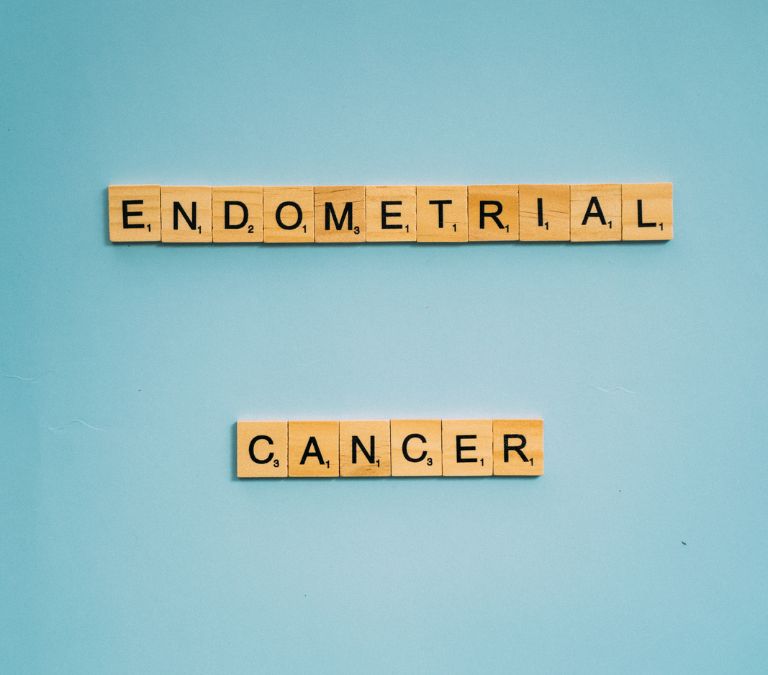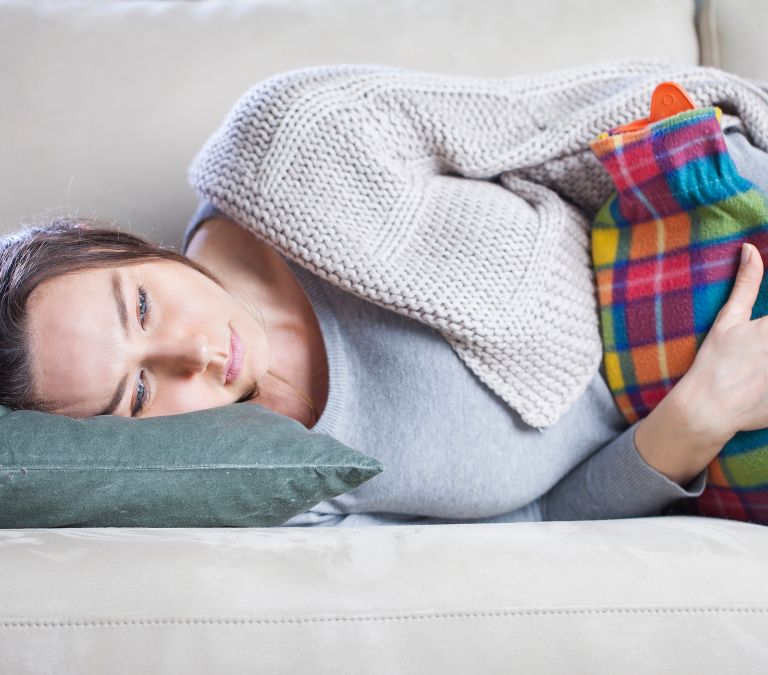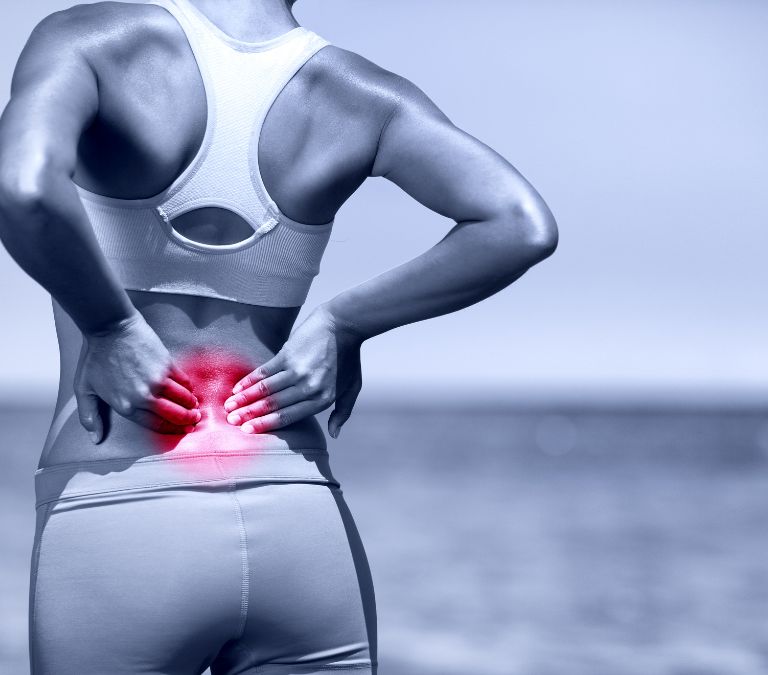Numerous studies and surveys have established that women encounter joint and spine pain during their life’s perimenopause and menopause stages. Hence it is not too surprising that many people are looking for information on menopause and back pain.
During menopause, many women experience physical symptoms like lower back pain, night sweats, hot flashes, reduced sex drive, and vaginal dryness which leads to painful sexual intercourse otherwise known as Dyspareunia.
A woman in her perimenopause and menopause stage is likely to experience more pain in the musculoskeletal system. The back, knees, neck, hands, and other significant joints expand for women as they grow older.
Also, few studies have revealed that more than half of the women undergoing this stage experience back pain which is a frequent manifestation.
Causes of Postmenopausal Cramping and Lower Back Pain

Many women experience cramps during their menstrual period. However, cramping can still happen after menopause and sometimes signify an underlying health condition. Different conditions can result in pelvic cramps postmenopause, some of which will be explicitly highlighted in subsequent paragraphs.
Endometriosis
The first condition responsible for menopause and back pain is endometriosis. It is a health condition in which tissue usually located in the uterus starts growing in other parts of the body, like the pelvis, bowel, or ovaries. During the menstrual period, the tissue swells up as it does in the uterus.
Endometriosis is most prevalent in women aged 30-40, but symptoms can still happen during postmenopause.
Typically, endometriosis affects women who still have periods and usually stops at menopause. However, several women in their postmenopause still complain of having endometriosis symptoms. Symptoms of endometriosis include:
- Lower back pain
- Pain during and after intercourse
- Urinary pain or pain during movement of bowel
- Cramp and pelvic pain
Endometriosis can negatively impact the lives of women and can sometimes cause depression. Sadly, taking hormonal therapy for symptoms of menopause can worsen endometriosis pain.
Gastrointestinal Ailments
Gastrointestinal ailments such as stomach virus, irritable bowel syndrome, or food poisoning can cause cramps in the lower abdomen. These cramps might come with other symptoms like vomiting, nausea, or diarrhea. Symptoms might be temporary and usually happens in certain situations, such as when the person is stressed or after eating dairy food
It is an infection of the digestive tract and can be caused by the following:
- a viral infection referred to as viral gastroenteritis or sometimes stomach flu
- a bacterial infection referred to as a food poisoning
Although many cases of gastroenteritis happen independently, some cases may require doctors’ attention or medication and can sometimes lead to hospitalization.
Patients who experience chronic diarrhea and vomiting can quickly become dehydrated, leading to serious health complications or death.
Uterine Fibroids
Uterine fibroids, referred to as leiomyomas, are non-cancerous growth in the uterus wall or womb. Even though fibroids start earlier in most women, it is still frequent among women in their 50s and usually, stop growing or reduce after menopause. However, Some women may still show uterine fibroids symptoms such as cramps or pelvic pain in their postmenopausal stage.
Other risk factors can increase the chances of someone having fibroids. Some of the factors include:
- Obesity- 20% higher than healthy body weight is considered obese
- Family Background
- Barrenness
- Early Menstruation -starting menstruation at an early age
- Late menopause age
Endometrial (Ovarian and Uterine) Cancers

It is also known as cancer of the uterus or ovary. It can result in abdominal cramps, and the risk of getting these cancers increases at 50 and above. Having abdominal Cramps alone is not sufficient to conclude you have endometrial cancer. Other symptoms that can combine with cramps to show evidence of cancer are listed below
- Vaginal bleeding
- Belly bloating
- Tiredness
- Weight loss
Endometrial cancers can lead to pelvic or abdominal cramping. Older women have a higher chance of contracting these cancers than younger women.
Chronic Constipation
Another common cause of lower pelvic pain and gastrointestinal upset is chronic constipation. Constipation happens when you have less than three bowel movements in a week. Hard, lumpy, or dry and painful stools difficult to excrete are constipation symptoms. The causes of constipation are highlighted below:
- lack of exercise
- low fiber diet
- some medical conditions
Patients who have severe or chronic constipation should consider seeing a doctor.
Also, certain factors can contribute to having back pain in the postmenopausal stage. The elements are highlighted below.
- Bone Density
- Body Mass Index
- Inflammation
- Hormonal Changes
- Stress and Anxiety
- Postural Changes
- Dehydration
Bone Density
Women’s bone density tends to decline as they approach and pass menopause, and it’s because there is a reduced percentage of calcium in the body. Unfortunately, studies have revealed a strong negative correlation between lower back pain and bone density. As bone density decreases, lower back pain increases and vice versa.
Body Mass Index (BMI)
Weight gain is typical among women during or after menopause, and body mass index also increases back pain in women within this age bracket. A BMI score of 30 or more is established to aggravate back pain.
Inflammation
inflammation causes spine pain in the body by pressing on the sensitive nerves. There is convincing evidence that perimenopause causes inflammation in the body and can exacerbate back pain for some women, even though the concepts are not fully understood yet.
Hormonal Changes
Hormonal changes can be the reason for the lower pain. It is understood that estrogen is needed to keep ligaments, tendons, and discs friendly and flexible. If your estrogen level decreases, this can shrink the spine, which can have a massive impact on the flexibility and movement of your spine. That can cause discomfort and back pain.
Stress and Anxiety
If you’re stressed and anxious, especially if it happens over a long period, the chemicals released from the stress and anxiety are very inflammatory. Over time, these inflammatory chemicals can navigate the body and affect every joint. The spine joint will be affected, and this can cause back pain.
Postural Changes
Bad posture can cause lower back pain, especially in postmenopausal women. The backbone can become affected if you spend a long time sitting at the desk, not moving, or not getting enough exercise.
Furthermore, pains in the upper back can relocate to the lower back. So spending a long time hunching over the computer without caution can put pressure on the lower spine, and you can end up with back pain.
Dehydration
Dehydration is a crucial aspect that most people do not associate with back pain. Dehydration frequently occurs in menopausal women because of falling estrogen, sweats, and flushes. Your kidneys struggle when you’re dehydrated because a lot of pressure is exerted on them. This pressure often leads to lower back pain.
Moreover, rather than on the spine itself, this pain will be on either side of the spine. So if you find that you’re getting this kind of pain on both sides of your spine frequently, it could be a clear sign that your kidneys are starved for a good amount of water.
Other associated symptoms with pelvic cramps in the postmenopausal stage are listed below.
- Pain during sexual intercourse
- light, medium, or heavy vaginal bleeding
- abdominal swelling or bloating
- Leg pains or swellings
- Fatigue
- Urinary Pain or during bowel movements
- Constipation
- Weight loss or gain
- Diarrhea, nausea, or vomiting
Diagnosis of Postmenopausal Cramps and Pain

To diagnose postmenopausal cramps and pain, the doctor might recommend some tests to check for underlying health conditions accurately. Symptoms and medical history of the patients are paramount to the doctor before a physical examination. One of the following highlighted tests might reveal underlying conditions causing abdominal cramps.
Transvaginal ultrasound scan
A transvaginal or endovaginal ultrasound scan is an internal examination of the female reproductive system. It is a safe and easy way of examining the female pelvic region. An ultrasound utilizes the high frequency of sound waves to produce a comprehensive pictorial view of internal organs.
The doctor will inject a small transducer device into a patient’s vagina to diagnose problems. These scans can help to diagnose:
- Non-cancerous or benign growths like cysts, fibroids, and masses
- Pelvic inflammatory disease
- Endometriosis
- Bleeding occurs after menopause.
Hysteroscopy
A hysteroscopy is a procedure used to examine the inside of the womb or uterus. The process is carried out using an instrument called a hysteroscope. It is a narrow telescope with a camera and light at the end, and the images it produces are transferred to the monitor so the doctor or nurse can see inside the womb.
The hysteroscopy procedure involves no cut on the skin as the hysteroscope is usually passed into the womb through the womb’s entrance (vagina and cervix). It is used to diagnose
- symptoms or problems like unusual vaginal bleeding, heavy bleeding, pelvic pain, and postmenopausal bleeding
- Conditions relating to non-cancerous growth in worms such as fibroids and polyps
Doctors will pass a hysteroscope through the vagina and into the patient’s womb to gather a thin tube with a camera, known as a hysteroscope, through the vagina, and into a person’s womb to collect a tissue sample for testing.
Before hysteroscopy, a procedure referred to as D&C (dilatation and curettage) is usually used in examining the womb to eject abnormal growths.
Endometrial Biopsy
This procedure is carried out to examine or remove the endometrium, a small piece of tissue from the lining of the uterus, with the help of a microscope for cancer and other cell irregularities.
A doctor will inject a thin tube into the woman’s womb to gather a tissue sample and examine for signs of cancerous or abnormal cells.
Sonohysterography
Sonohysterography is a procedure to examine the inside of the uterus. It’s a safe and painless procedure that creates an image using sound waves and a computer.
The doctor will put a saltwater solution into a patient’s womb and then do an ultrasound to detect possible problems.
Dilation and curettage
A Dilatation and Curettage (D&C) procedure is a surgical process whereby the cervix is expanded so that the endometrium (uterine lining) is removed with a spoon-shaped instrument called a curette to eradicate abnormal tissues.
A doctor opens the patient’s cervix and collects a sample of the womb lining using a thin tool. The model is examined to check for possible signs of abnormal growths like endometrial hyperplasia, polyps, or cancer.
It is a standard procedure to examine the womb lining before accepting hysteroscopy.
Treatment of Postmenopausal Cramps and Pain
Treatment for postmenopausal cramps varies depending on the underlying conditions. Some viable treatment options are highlighted below;
Progestin Therapy
Doctors prescribe progestin therapy primarily to treat patients experiencing endometrial hyperplasia. Progestin therapy can be taken as oral tablets, vaginal creams, injections, or as an intrauterine device fitted by a doctor.
Dilation and curettage (D&S) Surgery
A doctor chooses to perform dilation and curettage (D&S) surgery to discard the uterine lining’s thickened parts due to endometrial hyperplasia.
Hysterectomy
Hysterectomy surgery is usually done to remove all or part of a woman’s womb. Doctors commonly use hysterectomy surgery to treat large fibroids, cervical cancer, or endometrial.
It also treats precancerous endometrial hyperplasia and cancer treatments like radiation therapy, hormone therapy, and chemotherapy.
Depending on the form of cancer and stage, one or all of the treatments might be prescribed by the doctor.
Menopause and Back Pain Connecting the Dots…
Upper back pain, also known as UBP, refers to pain within the thoracic spine region. It is a prevalent and disabling condition among women following their menopausal stage. It contributes significantly to reducing women’s quality of life.
It is estimated that women are likely to have a lifetime occurrence of upper back pain between 6% and 72%. Yet, risk factors relating to upper back pain have not been vividly identified but could include a series of individual physical characteristics.
Physical characteristics such as spine mobility, trunk strength, and poor posture have been estimated to correlate with upper back pain directly. Hence, they are associated with Upper back pain among women in their postmenopausal stage.
Furthermore, the following factors have been considered to upsurge the likelihood of upper back pain
- Decreased bone mineral density or BMD.
- Existence of thoracic vertebral fractures.
- Increased thoracic hypnosis.
However, these factors are yet to be examined simultaneously. Therefore, interpretations of reports are complicated because most of these factors vary with increased age and are more likely to occur in the postmenopausal stage.
Natural Remedies You Can Try to Help With Menopause and back Pain or Cramps

There are many things you can practice to reduce perimenopause or postmenopausal pain. Below, we have highlighted and explained possible ways to manage chronic pain in menopause.
- Engage in relaxation techniques. You can practice yoga and mindfulness meditation.
- Stay active. Don’t just sit at a spot every day so your condition will not aggravate. Even on bad days, set minimum goals for physical activities like walking or jogging.
- Reduce Stressful activities -Stress elevates your perception of pain, so learn to say no to that energy-draining activity so you won’t get stressed or tired.
- Take enough sleep regularly- Lack of sleep worsens pains, and a survey reveals that making sleep a priority results in having better rest which can help reduce pain and calm the body.
- Reduce caffeine and alcohol intake in the evening.
- Take enough water every day. Water not only hydrates your kidneys but ensures your tendons, ligaments, and joints are well hydrated. You will experience minimal back pain or cramps if you’re hydrated enough.
- Don’t slouch- yes, it’s easier said than done but ensure you don’t sit, stand or sleep in an awkward position. Be aware of your posture every time, as it can help reduce fatigue. Watch online videos or tutorials to correct your posture if you feel it’s getting worse
- Consider your sleep environment and position- poor sleep affects your back, especially if you use the wrong mattress or pillows. Check your pillows or mattress regularly. It could be too flat or worn out, which can cause back problems.
- Consider taking herbal medications for back pain – there are tremendous herbal drugs that are natural anti-inflammatory if you have a lot of inflammation.
- Stretching- Stretching is vital; you can do it anyway. Try stretching regularly at your home, office, or playground to get yourself fit and friendly.
- Engage in low-impact exercises- This can be helpful. You can consider doing activities like brisk walking and swimming.
What Causes Ovary Pain during Perimenopause?
Abdominal cramping pain is a regular occurrence among most women during their menstruation, including pain in the uterus or womb and the ovaries. The muscles of the uterus contract regularly to assist the uterus shed its lining every month. The contraction is what leads to menstrual cramps.
When the lining of the uterus cells breaks at the beginning of the menstruation period, Prostaglandins are usually released. These lipids make blood vessels within the uterus constrict, get thinner or smaller, and cause the constriction of the outer muscular layer. During this constriction process, a cramping response occurs.
Furthermore, during perimenopause, some women experience prolonged and heavier bleeding and intense cramping during the menstrual period. These changes result from the fluctuations in estrogen levels and the lowering of progesterone levels.
A woman can also feel pain within the ovary region before menopause for numerous reasons unrelated to menstruation. Some of these reasons are highlighted below
- Uterine or ovarian cysts or any irregular pockets filled with fluid. They are usually not harmful because of size but can rupture and lead to pain and cramping if they are large
- Non-cancerous growth in the uterus that presses the pelvic organs
- Polycystic syndrome in the ovary referred to as PCOS
- Pelvic infections
Women are more prone to develop ovarian cancer during the postmenopausal stage.
However, non-cancerous or benign growths can give similar symptoms. Some common signs of ovarian cancers are listed below.
- Chronic pain
- Feeling bloated and full suddenly after beginning eating
- Frequent feeling of urinating
- Unexplained exhaustion
- Menstrual changes
- Pain during sexual intercourse
Do Ovarian Cysts Cause Lower Back Pain in Women?
Ovarian cysts are little benign(non-cancerous) sacs filled with fluid that occur primarily in women with regular menstrual periods. They’re an inconvenience for women and can reduce their quality of life. They often cause disturbing symptoms such as abdominal pain or discomfort and periodic bloating. In some instances, they can lead to severe lower back pain.
There are numerous forms of ovarian cysts. Most usually happen due to a woman’s regular menstrual cycle, when sacs filled with fluid grow continuously rather than releasing eggs from the ovary during ovulation.
Pregnancy, endometriosis, or any hormonal changes that influence ovulation are some of the factors that could expose a woman to an upsurge risk of ovarian cysts.
Fortunately, ovarian cysts leave the victim on their own without any medication or surgery. Interestingly, several ovarian cysts patients are unaware of the problem because they come and go without revealing any visible symptoms. In cases where symptoms are apparent, self-care practices such as using a heated pad to reduce back pain can relieve the symptoms.
Consider speaking to a doctor if you experience any unusual or new symptoms. Lower back pain can make it challenging or uncomfortable to perform daily tasks. Ensure you visit a doctor for diagnosis or consider visiting a gynecologist for consultancy.
More symptoms of ovarian cysts include:
- Bloating and abdominal pain
- Pain in the pelvic region
- Dull thighs ache
- Uncommon vaginal bleeding
- Pain during sex
- Constant urination
If you experience severe or chronic pain in the pelvic region or perhaps if symptoms result in fever, vomiting, or nausea, an ovarian cyst might have broken or ruptured an ovary.







